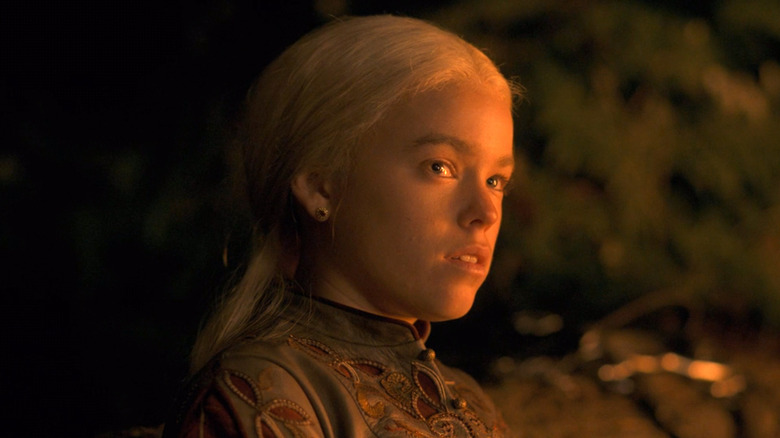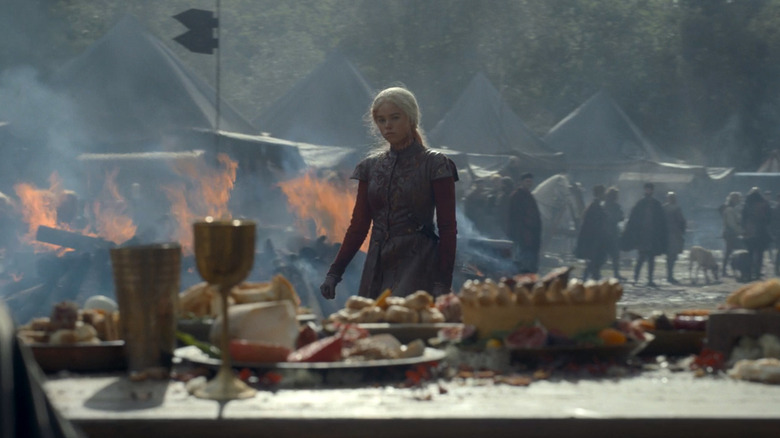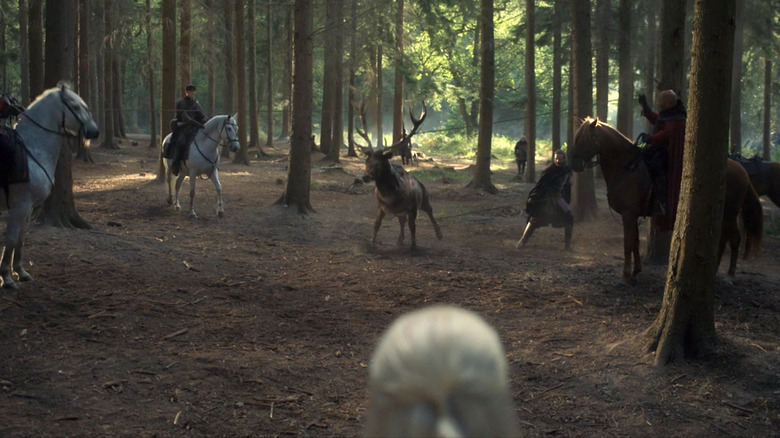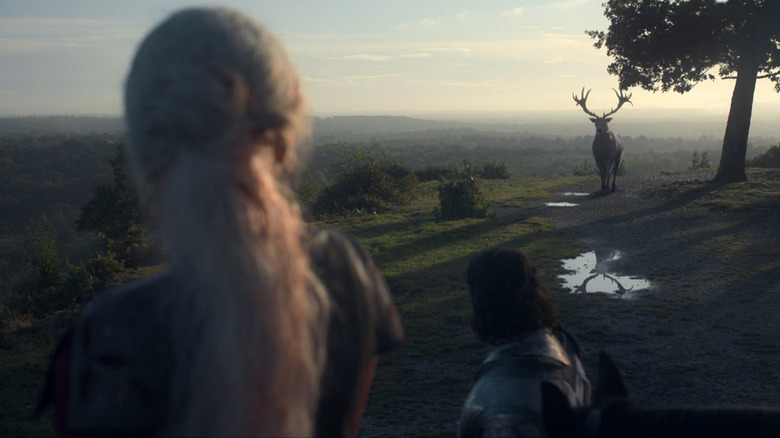Unpacking The Symbolism Of House Of The Dragon's Big Hunting Sequence
This article contains spoilers for "House of the Dragon" episode 3.
When it comes to symbolism and metaphors, "Game of Thrones" and "House of the Dragon" have never known subtlety. Animals have always served as major symbols for characters, not just including the creatures associated with each noble house, but also defining important character traits and serving as omens. For example, in the very first episode of "Game of Thrones," the Stark children find the corpse of a dire wolf mother that was mortally wounded by a stag, and there is one wolf pup for each Stark child, including an albino pup for Jon Snow (Kit Harrington). The mutually-assured destruction by the stag and the wolf represent how Robert Baratheon (Mark Addy) and Ned Stark (Sean Bean) would eventually cause each other's demise. And Ghost, the albino pup? Let's just say his white fur might have something to do with Jon Snow's true heritage.
In episode 3 of "House of the Dragon," the Targaryen royal family goes on a hunt to celebrate baby Aegon's second name day (or birthday), and they encounter some animals with pretty intense metaphorical meanings. Princess Rhaenyra (Milly Alcock) slays a boar, King Viserys (Paddy Considine) sort of slays a stag, and a white hart bestows its grace on only one of them. But what does it all mean?
Rhaenyra's boar depicts her strength
Rhaenyra is supposed to be the heir to the throne, but there has never been a ruling Queen in the history of Westeros and it's not likely that the people will follow her. Aegon has survived the most worrisome years of infancy, which makes him a viable candidate for the throne and one the people are more likely to support. Viserys must decide whether to stand by his daughter or go with the wishes of his small council and put Aegon forward as heir, but deciding isn't really his forte. Frustrated with it all, Rhaenyra leaves the hunting camp to go off on her own, and is followed and joined by Ser Criston Cole (Fabien Frankel). While the two of them are chatting by the campfire, a wild boar runs in and attacks Rhaenyra. Rhaenyra is flat on her back and Cole manages to stab the thing, but it jumps back up and goes after her again. The princess grabs her knife and stabs the boar repeatedly, staining her impressive armor-esque dress and hair with blood in the process.
When Rhaenyra returns to her father's camp, she brings the boar with her. It stuns the camp, including many of the older, male soldiers and lords who are shocked to see the princess bloodied and ultimately successful in a hunt. Wild boars are nothing to be trifled with, but then again, neither is Rhaenyra. It's worth noting that the other important boar in the franchise killed Robert Baratheon when it gored him. Sure, he was drunk, but he was a massive man with war experience. In the end, the boor lost to the boar, but the dragon princess did not.
Viserys's stag depicts his weakness
Rhaenyra may have killed a boar with just a little help from Ser Cole, but Viserys requires the help of an entire team of men and horses to help him take down a stag. Though there had been sightings of a white hart, or a large white stag, the hunting party were only able to find and capture a regular stag for Viserys to kill. Unlike King Robert, who had been quite the hunter in the prime of his life, Viserys seems to lack even the most basic knowledge of how to properly hunt. He is helped off of his horse with the use of a removable staircase, for the sake of the Seven, and he doesn't even know where to stab the creature to end its life mercifully. He's as untried as the knights trying to win women's favors back in the premiere, and in many ways an unfit king for Westeros.
When Rhaenyra returns the morning after Viserys's pathetic showing with a hefty wild boar, it shows the men that maybe she is fit to be ruler. After all, she has more physical prowess than her father, and might prove to have more tactical skills as well. Unfortunately, Viserys is surrounded by those who want him to put Aegon forward as heir, including his new wife and Rhaenyra's former friend, Alicent Hightower (Emily Carey).
The white hart is the spirit of Westeros
Before Aegon Targaryren (the first, not Rhaenyra's younger half-brother) united the Seven Kingdoms of Westeros, the Crownlands were ruled by other kings whose sigil was a stag, much like House Baratheon's. The white hart is a near-sacred symbol of not only the people who first settled the Crownlands, but of the land itself. It represents the smallfolk, nature, and the land, and thankfully was not captured by Viserys's men. Instead, the hart appears the morning after Rhaenyra has slain the boar, stepping out into a clearing and staring her down. The two have a moment, and she stops Ser Cole from drawing his sword and going after the magnificent beast. She understands that there is no real point in killing the stag beyond bragging rights, and it deserves life as much as they do. This follows with the series' theme so far, in which the women of Westeros realize the sanctity of life far more than the men who play at war.
There's sure to be more animal-based symbolism in future episodes of "House of the Dragon," especially given that some of the main characters are tied to critters like dragons and crabs, but this week's hunting excursion gave fans plenty to think about. Does the hart's seeming approval of Rhaenyra signify that she is the one who should rule Westeros? Or will men have the final say?
New episodes of "House of the Dragon" premiere on Sundays on HBO and HBO Max.



